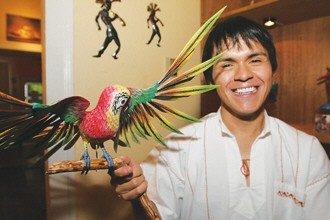| San Antonio native Jacob Maldonado is Randall Kurzon’s business partner in the Inter Artisan Gallery on South Alamo. Photo by Justin Parr. |
Among his other interests, Kurzon has always liked the idea of living aboard a boat. So rather than hang onto the family homestead in Tennessee, he liquidated that inheritance and bought a 55-foot wood trawler and moved aboard in 2004. The boat was a bargain at $65,000. Kurzon paid cash, and sank an additional $80,000 into renovations.
Kurzon’s home port, Slidell, Louisiana, was thought to be among the most protected ports along the Gulf Coast. Shortly before leaving to visit friends in Colorado to escape the humidity in August 2005, Kurzon secured his craft to its slip with industrial-strength cleats and lines.
But the marina was no match for Hurricane Katrina’s storm surge, which came ashore August 29, destroying about 290 of the 320 boats docked there. Kurzon’s new home was impaled on one of the nearby pilings.
“It was like a stake, driven through its heart,” Kurzon says, wincing at the memory. As it slowly sank, most of the boat filled with muddy water, and almost all of Kurzon’s belongings were destroyed.
The few boats that could be salvaged, ironically, had weaker tie-downs, Kurzon says. They broke free early, drifted inland, and were left high-and-dry, hulls damaged but intact.
Two weeks after the storm, Kurzon got his first look. “It was like Baghdad. I couldn’t even find my way to the marina at first — everything had changed.”
The storm’s psychological impact was just as disorienting. The boat was more than a home for Kurzon, it was a dream — the culmination of “everything in life that I wanted to do,” Kurzon says, and it was all suddenly taken away.
Like others living in boats or on RVs, Kurzon is ineligible for Road Home funding, and with liability coverage but no property coverage, he hasn’t been able to get any assistance from FEMA.
Fighting depression, Kurzon pursued Dream B. Fluent in Spanish, Kurzon had taken many trips to Mexico and admired much of the country and culture was there, including the fresh fish on the Oaxacan coast and the wood carvings, pottery, and other folk art. In need of a business partner, Kurzon linked up with a younger relative of one of the people he had met as a part-time court translator in Tennessee — San Antonio native Jacob Maldonado.
Partly because of air-freight logistics, Kurzon postponed the fish venture in favor of folk art purchased directly from international artisans, calling the new business “Inter Artisan.” Folk art also proved to be a better fit for Maldonado, a vegetarian.
Maldonado, now 23, scoped out the San Antonio arts scene, rented canopy space near King Willie’s BBQ (now just King Willie’s) for First Friday in March and April 2006, and secured a one-room display space at their current location, 1036 S. Alamo, soon afterward. An expansion to a second room in August 2006 allowed for a larger selection of items, including cobre goteado, dripped copper art, crafted by Arte Jimenez artisans in Jalisco, Mexico.
The first thing a visitor sees upon entering the gallery-like shop, shaded by large trees in the front yard, is a series of intricate and brightly painted Oaxacan wood carvings by Zeny Fuentes, including delicate mosquitoes, orchids, and hummingbirds. The lighting is subdued and accented, and plastic risers give the black Oaxacan Doña Rosa pottery and ceramics the appearance of levitating off the shelves that Maldonado built for the store, with help from his mom. The percussive beat of indigenous music, that Maldonado found online mingles with the scent from warm aromatherapy oil.
Kurzon is an avid photographer, and Maldonado puts small photos of the artisans who create the items on display in small plastic frames, near equally small explanations of who they are, where they’re from, and their artwork.
In the next room, visitors can watch a video of the artisans producing the dripped copper designs displayed on the wall. Just ask, and Kurzon or Maldonado will tell you how the Doña Rosa pottery gets its black sheen from smoke, not dye or glazing, or how the Mata Ortiz artisans create their intricate designs using brushes made with fine hair snipped from their daughters’ heads.
Almost everything on display is purchased directly from the artisans themselves. Kurzon and Maldonado walk around the Mexican villages, find the special pieces they’re looking for, and usually get invited to share meals and stories with the artisans’ families. They say they never haggle for a lower price, and limit their retail prices to a “keystone” (double cost) markup.
The connection between the art and the artisans is real, and some customers don’t need the photos and looping video to feel it. A local woman wearing an outfit styled on the Mixtec people of Oaxaca stood in front of one of the larger Doña Rosa pots for “20 or 30 minutes” Maldonado says. He noticed that her eyes were wet with tears.
“It’s all so beautiful, so powerful,” the customer said, according to Maldonado. She said she could feel the spirit of the artisans in the work on display.















